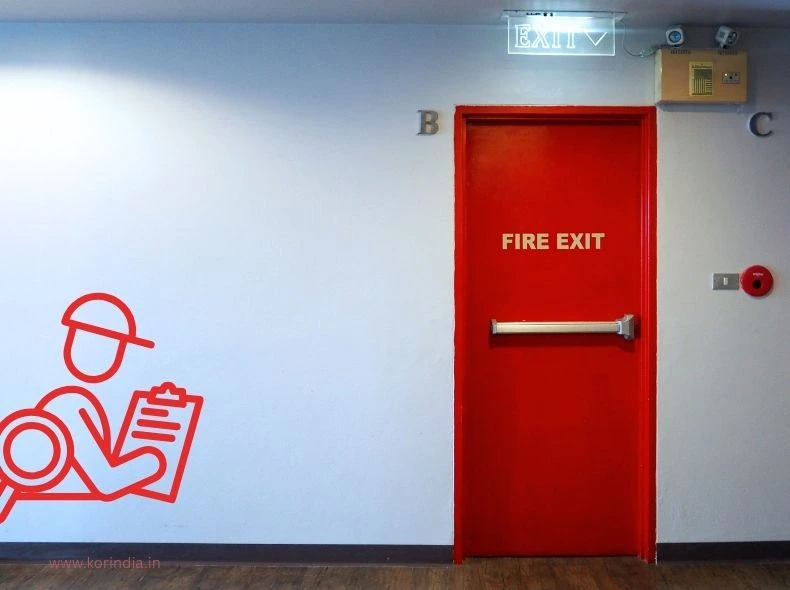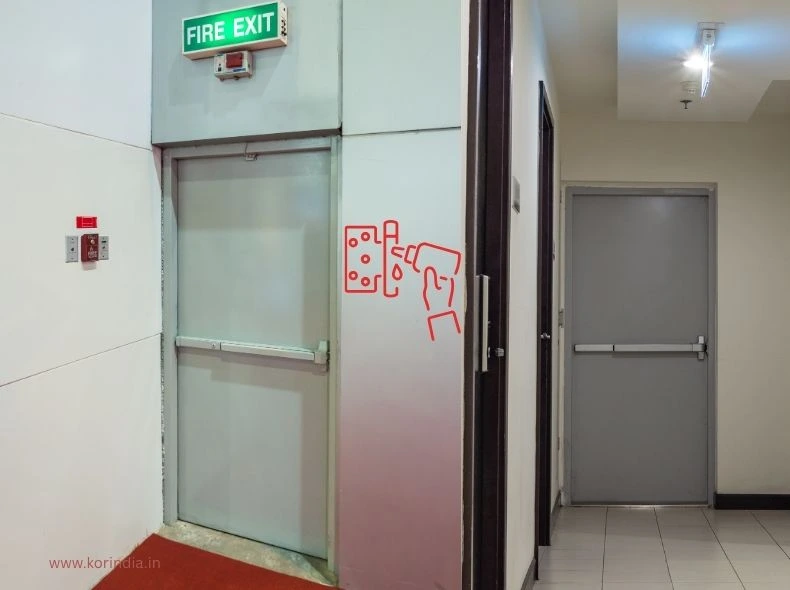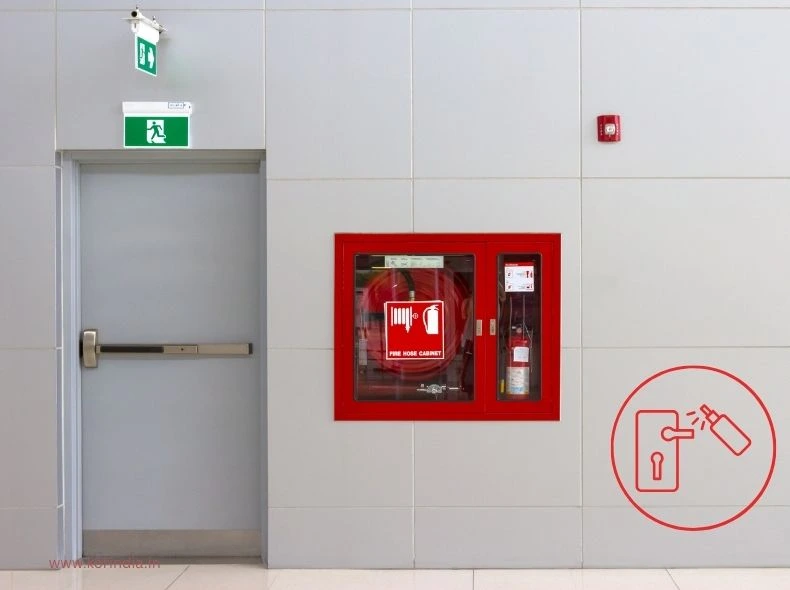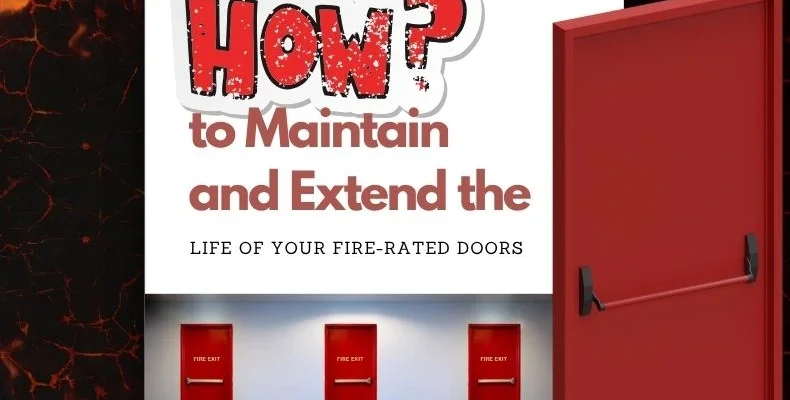Introduction: Fire-Rated Doors-Your First Line of Defense
Korindia Fire-rated doors serve a critical role in building safety, designed to contain fire and smoke and protect lives during emergencies. These specialized doors create barriers that slow the spread of fire, allowing occupants more time to evacuate and reducing property damage. However, even the best-constructed fire-rated doors require consistent maintenance to function effectively when needed.
Neglecting routine care can compromise door integrity, lead to failed inspections, increased repair costs, and- most importantly- endanger lives. This comprehensive guide walks you through the essential maintenance practices that ensure your fire-rated doors remain reliable, compliant, and durable over time. With proper upkeep, these doors can provide safety and peace of mind for decades.

Why Maintenance Is Crucial for Fire-Rated Doors
Designed for Extreme Conditions, but Not Indestructible
Fire-rated doors are engineered to perform under intense heat, smoke, and pressure, but day-to-day wear and environmental factors can degrade their performance. Regular maintenance is not just recommended; it is a legal requirement in most jurisdictions to keep doors compliant with fire safety regulations.
Key Benefits of Proper Maintenance
- Ensures Optimal Performance: A well-maintained door will close, latch, and seal properly in an emergency, providing the expected level of protection.
- Maintains Compliance: Building codes and fire safety standards require periodic inspections and maintenance, typically every 6 to 12 months.
- Saves Costs: Early identification and repair of minor issues prevent expensive replacements or major repairs.
- Extends Lifespan: Proper care can double or even triple the life expectancy of fire-rated doors.
The Longevity Potential
Fire-rated doors, when maintained, can last 20+ years or more. Conversely, neglect can reduce their effective lifespan by half or more, severely compromising safety.
Common Issues Affecting Fire-Rated Doors
Understanding typical problems helps facility managers identify signs before they escalate:
1. Damaged or Worn Seals
Intumescent seals expand during a fire to close gaps between the door and frame, preventing smoke and flames from passing. Over time, exposure to dust, moisture, and repeated use can cause these seals to crack, shrink, or peel away, reducing their effectiveness.
2. Warped or Damaged Door Frames
Environmental conditions such as humidity, temperature changes, or water ingress can warp door frames, causing poor fit and preventing doors from closing fully.
3. Misaligned or Damaged Hinges
Loose, rusted, or damaged hinges can misalign doors, leading to gaps that break the fire seal. Additionally, this can cause doors to fail closing tests.
4. Faulty or Worn Hardware
Locks, handles, latches, and closers can wear out, stick, or break, impairing door operation.
5. Obstructed Door Paths
Furniture, equipment, or debris blocking the door prevents it from closing and latching securely—critical failures in fire safety.

Detailed Steps to Maintain Fire-Rated Doors
Regular, thorough maintenance is vital. Follow these steps for comprehensive care:
1. Perform Regular Visual and Functional Inspections
- Frequency: Every 6 to 12 months, more often in heavy-use areas.
- What to Check:
- Door surface and frame for warping, dents, or corrosion.
- Hinges and hardware for wear, rust, or looseness.
- Intumescent and smoke seals for cracks, brittleness, or missing sections.
- Door alignment and closing force—doors should close firmly without sticking.
- Door surface and frame for warping, dents, or corrosion.
2. Clean Doors and Components
- Use a soft cloth and mild detergent to clean door surfaces. Avoid harsh solvents or abrasive materials that can damage seals or coatings.
- Pay special attention to hinges, locks, and seals, removing dust and debris. Dirty seals may not expand properly in fire conditions.
- For metal parts, use lubricants recommended by manufacturers to prevent rust without attracting excessive dirt.
3. Test the Self-Closing Mechanism
- The self-closing device ensures fire doors close automatically after opening.
- To test, open the door fully and allow it to close by itself. It should close smoothly and latch securely.
- Adjust tension or repair/replace the closer if the door fails to close properly.
4. Check and Replace Seals and Gaskets
- Seals are the heart of fire-rated door effectiveness. Look for tears, gaps, hardened or loose seals.
- Replace damaged or degraded intumescent and smoke seals immediately—these parts are typically modular and replaceable without changing the entire door.
5. Lubricate Hinges and Locks Properly
- Apply non-flammable lubricant sparingly to hinges, lock mechanisms, and latches. Excess lubricant can trap dust, so clean old grease before applying new.
- Ensure locks operate smoothly—sticking locks can prevent full door closure.
6. Address Surface Damage Promptly
- Inspect the door for scratches, dents, or rust spots.
- For steel doors, sand and repaint areas showing corrosion with fire-rated paint to prevent further damage.
- For wooden doors, repair chips or cracks with approved fire-rated fillers and coatings.
7. Verify Compliance After Building Modifications
- Any renovations or alterations affecting door frames, walls, or hardware require reassessment of fire rating compliance.
- Avoid installing non-certified hardware that could invalidate fire rating.
Best Practices to Extend Fire-Rated Door Life
Educate Building Occupants and Staff
- Train everyone not to prop open fire doors, which damages seals and compromises safety.
- Discourage slamming doors which can warp frames and dislodge hardware.
Install Protective Kick Plates and Door Guards
- Especially in high-traffic areas, kick plates protect the lower door surface from impacts.
Use Certified Fire-Rated Hardware
- Always choose fire-rated locks, closers, hinges, and handles designed to withstand fire conditions.
Respond Quickly to Minor Issues
- Don’t delay repairs for sticking hinges, loose hardware, or chipped seals. These seemingly small problems can become major safety hazards.
Schedule Professional Maintenance and Inspections
- Certified fire door technicians can perform detailed inspections, functional tests, and repairs that meet local regulations and manufacturer guidelines.
Signs Your Fire-Rated Door Needs Replacement
While maintenance extends door life, replacement becomes necessary if:
- Warping or cracks compromise the door structure.
- You face frequent seal failures despite replacement attempts.
- Rust or corrosion is extensive and affects strength.
- Doors fail fire safety inspections or no longer meet code requirements.

How KORINDIA Doors Simplify Maintenance and Longevity
KORINDIA designs fire-rated doors with ease of maintenance in mind:
- Durable Materials: Resistant to moisture, warping, and corrosion.
- Long-Lasting Seals: High-quality intumescent and smoke seals tested for durability.
- Custom Hardware: Fire-rated certified components designed for performance.
- Support Services: Expert after-sales support for inspections, maintenance advice, and repairs.
With KORINDIA, building managers get peace of mind knowing their fire-rated doors are built to last and easy to maintain.
Frequently Asked Questions About Fire-Rated Door Maintenance
Q1: How often should fire-rated doors be inspected?
A1: Inspections every 6 to 12 months are recommended. High-traffic or critical areas may require more frequent checks.
Q2: Can I replace fire door seals myself?
A2: Minor seal replacements can be done with proper guidance, but professional replacement ensures certification and effectiveness.
Q3: What maintenance steps can I do in-house?
A3: Cleaning, lubrication, and visual inspections can be performed by trained staff. Mechanical repairs and seal replacements should be done by professionals.
Q4: Are fire-rated doors expensive to maintain?
A4: Routine maintenance is cost-effective and prevents costly repairs or replacements, protecting your investment.
Q5: What happens if a fire-rated door fails inspection?
A5: Failure requires immediate repair or replacement to maintain compliance and safety.
Conclusion: Protect Lives and Property with Proper Fire-Rated Door Maintenance
Fire-rated doors are a cornerstone of building fire safety, but their effectiveness depends heavily on regular inspection and care. By implementing the best maintenance practices outlined here, you can ensure your fire-rated doors provide reliable protection for many years, meet all regulatory requirements, and avoid costly repairs or replacements.
Interested in fire-rated doors designed for durability and easy maintenance?
Contact KORINDIA today to explore our premium range tailored for safety and longevity.

